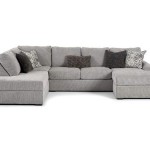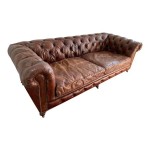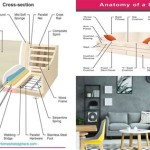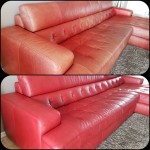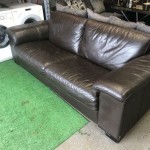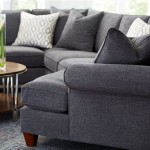The Prudent Choice: Navigating the World of Second-Hand Sofas
Acquiring furniture for a home often represents a significant financial investment. For individuals and families operating within a strict budget, or those prioritizing sustainability and resourcefulness, the acquisition of second-hand sofas presents a viable and often advantageous alternative to purchasing new items. The market for pre-owned sofas is extensive and diverse, offering a wide range of styles, materials, and price points. However, navigating this market effectively requires careful consideration and a strategic approach.
The decision to purchase a second-hand sofa should not be taken lightly. A thorough evaluation of the sofa's condition, its potential lifespan, and its suitability for the intended space is paramount. This article aims to provide a comprehensive overview of the key considerations involved in buying a second-hand sofa, empowering potential buyers to make informed decisions and secure a worthwhile investment.
Key Considerations Before Purchase: Initial Assessment and Inspection
Before embarking on the search for a second-hand sofa, it is crucial to define specific needs and preferences. This includes determining the required size and style of the sofa to complement the existing décor and accommodate the intended use. Consider the available space within the room and the number of individuals who will typically be using the sofa. Identifying the preferred material—whether it be fabric, leather, or a synthetic alternative—is also essential. These preliminary decisions will significantly narrow the scope of the search and facilitate a more focused evaluation of potential purchases.
Once a potential sofa has been identified, a thorough inspection is mandatory. Begin by visually examining the entire surface of the sofa, paying close attention to any signs of wear and tear. Look for stains, discoloration, rips, tears, or fading in the fabric. Inspect the seams for any unraveling or weakness. If the sofa is upholstered in leather, assess the condition of the leather, looking for cracks, scratches, or dryness. These visible defects can indicate the overall level of care the sofa has received and its remaining lifespan.
The structural integrity of the sofa is equally important. Check the frame for sturdiness and stability. Sit on the sofa and assess the support provided by the cushions and springs. Listen for any squeaking or creaking sounds, which could indicate loose joints or damaged components. Examine the legs of the sofa, ensuring they are securely attached and free from any signs of damage or weakness. If the sofa has reclining features, test each function to ensure it operates smoothly and reliably.
A critical aspect of the inspection is addressing potential hygiene concerns. Second-hand sofas can harbor dust mites, allergens, and other contaminants. If possible, inquire about the sofa's cleaning history and whether it has been professionally cleaned recently. Consider the potential for allergens, especially if individuals with allergies will be using the sofa. Ask about the presence of pets in the previous owner's home, as pet dander can be difficult to remove completely. Odor can also be a telltale sign of past issues. Sniff the sofa for any musty, smoky, or otherwise unpleasant odors. These odors can be challenging to eliminate and may render the sofa unsuitable for purchase.
Navigating the Second-Hand Market: Resources and Strategies
The second-hand sofa market presents a variety of avenues for acquisition. Traditional sources include thrift stores, consignment shops, and antique stores. These establishments often offer a curated selection of pre-owned furniture, providing an opportunity to physically inspect the items before purchase. However, the inventory at these stores can vary significantly, and the prices may not always be competitive. Estate sales and auctions can also be fruitful sources for finding unique or vintage sofas, but these venues require careful planning and a willingness to bid against other potential buyers.
Online marketplaces have revolutionized the second-hand furniture market, offering an extensive selection of sofas from individual sellers. Websites like Craigslist, Facebook Marketplace, and eBay provide a platform for connecting buyers and sellers directly. These platforms often offer more competitive prices and a wider range of styles than traditional brick-and-mortar stores. However, online purchases necessitate a higher degree of due diligence. Carefully review the seller's profile and feedback before initiating any transaction. Request detailed photographs of the sofa from multiple angles, and inquire about any known defects or issues. If possible, arrange to inspect the sofa in person before committing to the purchase. Be cautious of listings that appear too good to be true, as they may be indicative of scams or misrepresented items.
When negotiating the price of a second-hand sofa, consider the condition of the item, its age, and its original retail value. Research similar sofas online to gauge the current market price. Be prepared to offer a fair price based on the sofa's condition and any necessary repairs or cleaning that may be required. Do not hesitate to negotiate with the seller, especially if you identify any defects or issues that were not disclosed in the listing. Remember that the goal is to reach a mutually agreeable price that reflects the true value of the sofa.
Transportation is another crucial consideration when purchasing a second-hand sofa. Consider the size and weight of the sofa and the available space in your vehicle. If necessary, arrange for professional movers or rent a suitable vehicle to transport the sofa safely. Ensure that you have sufficient help to load and unload the sofa, as improper handling can cause damage to the sofa or injury to yourself.
Addressing Potential Issues: Cleaning, Repairs, and Restoration
Even with a thorough inspection, it is likely that a second-hand sofa will require some degree of cleaning or repair. Begin by thoroughly vacuuming the entire sofa, paying close attention to crevices and seams. Use a brush attachment to loosen any embedded dirt or debris. For fabric sofas, use a fabric cleaner specifically designed for upholstery. Follow the manufacturer's instructions carefully, and test the cleaner on an inconspicuous area of the sofa before applying it to the entire surface. For leather sofas, use a leather cleaner and conditioner to remove dirt and restore moisture to the leather.
Stains can be a common issue with second-hand sofas. Attempt to remove stains using a stain remover specifically formulated for the type of stain and the material of the sofa. Blot the stain gently with a clean cloth, working from the outside in. Avoid rubbing the stain, as this can spread it or damage the fabric. For stubborn stains, consider hiring a professional upholstery cleaner.
Minor repairs to the sofa may be necessary to restore its functionality and appearance. Loose seams can be easily repaired with a needle and thread. Missing buttons can be replaced with matching buttons purchased from a fabric store. Scratches or cracks in leather can be repaired with leather repair kits. For more significant repairs, such as broken springs or damaged frames, consider hiring a professional furniture repair technician.
In some cases, the sofa may require more extensive restoration. Reupholstering a sofa can significantly improve its appearance and extend its lifespan. However, reupholstering can be a costly undertaking, so it is important to weigh the cost of reupholstering against the value of the sofa. If the sofa has sentimental value or is a unique antique, reupholstering may be a worthwhile investment. When selecting a reupholsterer, choose a reputable professional with experience in working with antique or vintage furniture.
Finally, consider the overall aesthetic of the sofa and how it will fit into your home décor. If the sofa is in good condition but the fabric is outdated or clashes with your existing décor, consider adding throw pillows, blankets, or slipcovers to update its appearance. These accessories can be an affordable way to transform the look of a second-hand sofa and make it feel like a brand new piece of furniture.
By carefully considering these key points and implementing a strategic approach, individuals can successfully navigate the second-hand sofa market and acquire a valuable and aesthetically pleasing addition to their homes. This approach not only provides a cost-effective alternative to new furniture but also contributes to sustainable consumption practices and reduces environmental impact.

How To Buy Used Furniture 9 Tips Score Second Hand Treasure

Second Hand Sofas Wigan Bolton Manchester Starting From 75 Ex Display Marketplace

Second Hand Sofa

Second Hand And Used Sofa

New2you Furniture Second Hand Sofas Sofa Beds For The Bedroom Living Room Ref D57 Torrevieja Spain
Used Sofa For Second Hand Noida Ghaziabad Delhi

New2you Furniture Second Hand Sofas Sofa Beds For The Living Room Ref D871 Torrevieja Spain

The Best Secondhand Furniture S In Kl
Sofa Set For Sofas Couches Armchairs Gumtree

Fabric Sofas Alecs 3 Piece Suites
Related Posts

